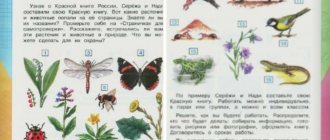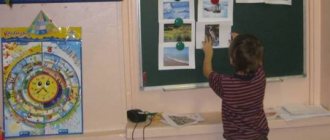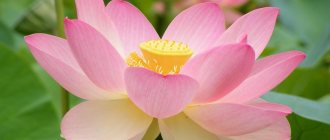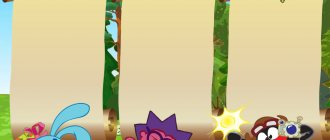The presented research project on the surrounding world (primary school) “The Red Book or Let's Take Under Protection” examines theoretical information about the protection of nature, animals, and the environment, and also provides brief information about the origin of the Red Book and why it is necessary.
In the process of research work on the surrounding world (primary school) “The Red Book or Let’s Take Under Protection,” a 3rd grade student set a goal to explore possible measures that, by taking which, a person can ensure environmental protection.
The research work on the surrounding world (primary school) “The Red Book or Let's Take Under Protection” provides information about the theory of the Red Book, and also tells about the Red Book of the Republic of Karelia.
In the proposed project on the environment (primary school) “The Red Book or Let’s Take Under Protection,” the author conducted a survey of students regarding their opinions on the need to ensure environmental protection and proposals for the implementation of this activity, and also listed the protected natural areas of the Republic of Karelia.
Introduction 1. The Red Book. 2. Red Book of the Republic of Karelia. 3. Protected areas. Conclusion References
RESEARCH WORK Lego project “Red Book. Animals” project on the surrounding world
RESEARCH
Lego project
"Red Book. Animals"
- Lego animals
- Lapbooks
- Conclusion
- Bibliography
Introduction
During our environmental studies, we became acquainted with the diversity of the animal world of our planet. For many thousands of years, man has explored all corners of the Earth. We build big cities, roads, and mine mineral resources.
At the same time, we do not spare the natural world: we cut down forests, dig deep ditches, litter rivers and lakes, mercilessly catch fish, and shoot animals. Nature is hard to bear the wounds inflicted on it by man. And asks for help and protection from a person.
The purpose of our work:
- Find out which objects are included in the Red Book.
- Find out why the pages of the Red Book are different colors.
- What measures can we take to preserve the number of animals?
Tasks:
- Find information from various sources.
- Determine the animals whose figures we will make using Lego sets.
- Create “Animals” laptops
- Conduct a survey of classmates to find out if they know about the Red Book, what species of animals are included in it and how to preserve endangered species.
Theoretical part
In the course of our work, we found out that: a special commission of the rescue service compiled a world list, which included animals and plants that were on the verge of extinction, and rare species. They decided to call this list the Red Book. The Red Book was established by the International Union for Conservation of Nature in 1966. It is stored in Switzerland, in the city of Morche. It contains data on birds, fish, animals, plants that urgently need protection. Red color signals: protect!
Many countries today compile their own Red Data Books. A similar book was created in Russia in 1974. Her lists included 52 species of animals and 65 species of birds. The list has been growing since then.
The pages of the Red Book are multi-colored. This is not for decoration. Therefore, on the page of which color the information about a given animal is contained, you can immediately determine in what position it is located
- - black pages
- - red pages
- - yellow Pages
- - gray pages
- - white pages
- - green pages
- The black pages contain those animals that we will never see again, such as the Passenger Pigeon.
The passenger pigeon is a very beautiful bird. These birds lived in old deciduous forests, where they found abundant food: beech nuts, chestnuts, acorns, and seeds. The habit of keeping in flocks, building nests and being in close proximity has turned them into easy prey for hunters. By 1890, wild passenger pigeons had become rare, and not surprisingly. The last passenger pigeon died in 1900.
- Particularly rare and endangered animals are recorded on the red pages. There are few of them, but you can still find them. They may disappear completely. They give people SOS signals. People! Be carefull. The red pages list plants, birds and animals that may soon become extinct.
For example: red wolf, snow leopard, Amur tiger
- My page is yellow. They symbolize the number of animals, which is rapidly decreasing. If we don't help them, they may end up on dangerous red pages.
For example: pink flamingo, polar bears, pink gull, gazelle, Egyptian heron.
- The green pages record animals that have been saved from extinction. Animals are bred in captivity to return them to their natural habitats. Animals must learn to survive in new conditions. There are currently more than 1,200 national parks in the world. National parks prevent soil erosion, conserve water resources and conserve medicinal plant resources. Nature reserves are created in order to preserve natural areas with their characteristic species of animals and plants in their natural state.
For example: elk, river beaver, bison.
- The gray pages contain the names of animals that are still little studied. Their habitats are difficult to access or not clearly established.
For example: Turtle, Emperor Penguin, White-faced Dolphin.
- The white pages are those animals that have always been few and far between. The pages contain specially protected natural areas. These are national parks and reserves. And also, animals that are still little studied or there is no accurate information about their condition. Back in the 19th century, people began to notice that some valuable plants and animals were becoming rare and even ceased to exist. It was in this regard that reserves began to be created, the task of which was to protect rare plants and animals from destruction. Nature reserves are islands of salvation for animals. On the territory of nature reserves in strict protection zones, all economic activities and any human interference in the natural state of nature are prohibited.
For example: Sika deer
Practical part.
Based on what we learned, we decided to interview our classmates. We wanted to know if they knew about the existence of the Red Book, any animals listed in it, and also how, in their opinion, the number of endangered and rare animals could be reduced.
During the survey, we found out that not all the children know what the Red Book is, they named few animals included in it, such as: Amur tiger, polar bear, mandarin duck, bison, panda, white crane, red wolf, Egyptian Heron, Snow Leopard, Sika Deer, Beavers and many others.
Lego animals
We decided to make some of the animals from Lego parts and turned to the teacher for help. She found us diagrams for assembling such animals. This is what we got.
In addition, the majority of respondents believe that the following measures must be taken to preserve endangered animal species:
- Create nature reserves
- Do not hunt or kill animals,
- fight poachers,
- restore endangered animal species,
- make feeders,
- The most important thing is to protect nature!
Lepbook
Together with my parents, we made a laptop about our animal. We looked for all the facts, information and data at home ourselves. Of course, with the help of adults. Our mothers wrote three or four words for each item, and we drew pictures instead of answers. And we got our own mini-encyclopedias about the animal.
So, what goes into our animal lapbooks?
1. The “Interesting Facts” pocket is used to store cards with collected facts about the animal.
2. Mini-book “Image in Art” - riddles, proverbs, titles of books and films about the animal being studied are collected here.
3. “Protection” strip - the protective status of the animal, the factors threatening it, and the measures that are taken to protect it are recorded.
4. Frame “Photo of an animal” - here we placed an image of the animal we have chosen (its photograph or drawing).
5. Fields for recording classification - our mothers wrote down basic information about animals (class, order, family, genus, species) in the appropriate boxes.
6. Strip “Appearance” - the distinctive features of the animal and its main characteristics are described.
7. Notebook “Lifestyle” - we entered basic information about the habits and behavior of the animal.
8. Map “Where does he live?” — on the contour map we marked the habitat of the animal.
9. Mini-book “Dwelling” - mothers wrote down basic information about the animal’s home, and we drew its habitats (dens, nests, burrows, etc.).
Conclusion
We realized that everyone is not indifferent to this problem and wants to join our project. We decided to continue working on our project further. In the future we plan to make our own Red Lego book. With our project we wanted to show that there are animals near us that need our protection. To do this, every person needs to learn to treat them with care. During the work on the project, all goals and objectives were achieved. The creation of the Red Book is the first step in the fight for the conservation of animals and plants that are in danger of extinction.
We love the forest at any time of the year.
We hear the rivers speaking slowly...
All this is called nature,
Let's take care of her!
Lifestyle and nutrition
It lives on drifting and fast sea ice, where it hunts its main prey: ringed seal, bearded seal, walrus and other marine animals. He catches them, sneaking up from behind shelters, or near holes: as soon as the animal sticks its head out of the water, the bear stuns the prey with a blow of its paw and pulls it out onto the ice. Sometimes the ice floe on which the seals are located topples over from below. A walrus can only be dealt with on land. First of all, it devours the skin and fat, the rest of the carcass only in case of severe hunger. The remains of the prey are eaten by Arctic foxes. On occasion, it picks up carrion, dead fish, eggs and chicks; it can eat grass and seaweed; in inhabited areas it feeds on garbage dumps. There are known cases of robbing food warehouses of polar expeditions. From its prey, the polar bear receives a large amount of vitamin A, which accumulates in its liver: there are known cases of polar bear liver poisoning.
It makes seasonal migrations in accordance with annual changes in the polar ice boundary: in the summer it retreats with them closer to the pole, in the winter it moves south, entering the mainland. Although the polar bear stays mainly on the coast and ice, in winter it can lie in a den on the mainland or on islands, sometimes 50 km from the sea.
During winter hibernation, lasting 50-80 days, mainly pregnant females hibernate. Males and single females hibernate for a short period of time and not annually.
Despite their apparent clumsiness, polar bears are fast and agile even on land, and in water they swim and dive easily. Very thick, dense fur protects the bear's body from cold and getting wet in icy water. An important adaptive role is played by a thick layer of subcutaneous fat up to 10 cm thick. White coloring helps camouflage the predator. The senses of smell, hearing and vision are well developed - a bear can see its prey from several kilometers away, a ringed seal can smell it from 800 m away, and, being right above its nest, it hears the slightest movement. According to the memoirs of Vice Admiral A.F. Smelkov, a swimming polar bear, pursued by a submarine, is capable of reaching speeds of up to 3.5 knots (almost 6.5 km/h)[6]. The record recorded bear swim was 685 km, made across the Beaufort Sea by a bear, swimming from Alaska north to the pack ice to hunt seals, while she lost 48 kg of weight (20%)[7].
Red List of Threatened Species
In addition to the Red Book, the IUCN produces special lists of threatened species. The first of them is dated 1988. According to the idea of the IUCN, each biological species has its own conservation status. There are 7 protection statuses in total. The first two of these are assigned to species that are either completely extinct (EX) or extinct in the wild (EW). Next come three more statuses:
- CR – on the verge of destruction;
- EN – endangered species;
- VU – vulnerable species.
Finally, the last two statuses are assigned to species that are close to vulnerable (NT) or not at all of concern (LC).
It is important to note that the International Red Book is not a legal document; rather, it is a reference book containing the most general recommendations for nature conservation.
Measures to protect endangered species
Each country is engaged in the protection of rare animals and plants located on its territory. Russia was no exception. We have created more than one and a half hundred nature reserves, more than a thousand nature reserves, and national parks.
Let's consider the main measures designed to increase the population size:
- ban on hunting, damage, and snatching of endangered specimens;
- the creation of nature reserves and reserves where nature is preserved in its original form;
- planting rare plants in botanical gardens and collection areas to create a reserve;
- breeding endangered animals in captivity and then releasing them into their natural habitat;
- resettlement of individuals in the territories where they lived before the arrival of humans;
- creating favorable conditions for living, constructing nests, shelters, feeders in winter.
Our projects page 204: Project “International Red Book”
The goal of the project: to learn about the history of the creation of the international “Red Book”, its goals, about the rare inhabitants of our planet, to find information about rare animals from the Red Book.
Project plan:
- History of the creation of the International Red Book
- Structure of the Red Book
- Orangutan is a close relative of humans
- Orangutan lifestyle
- Appearance, population
- Protecting orangutans
- Presentation example
Subsequent editions
The first Red Book listed only birds (312 species) and mammals (211 species). Over time, the information was clarified and refined. The second edition began publication in 1966. Scientists did not understand why the mass reader needed the Red Book, so it was impossible to find it in a regular store. The work was distributed among ecologists and specialized specialists.
In 1972, volumes of the third edition began to be published. Each species was described in detail, its habitat, abundance and other characteristics were indicated. The last edition of the book was published in 2012. It includes a list of 63,837 species. 19,817 of them are in serious danger.
Report to the project “International Red Book”
When the International Union for Conservation of Nature was created in 1948, its main goal was to protect endangered animals. The list of these animals is called the International Red Book.
The first edition of the book appeared in 1963 and included a total of 211 species of mammals and 312 species of birds.
But by the fourth edition, published in 1980, this list had increased to 226 species of mammals, 258 species and subspecies of birds, and included reptiles, amphibians and fish.
Changes since 1988
Since 1988, a supplementary Red List of Threatened Species has also been published.
All species included in the list are divided into several groups, each group is located on pages of its own color.
The first group contains species that are directly threatened with extinction.
The second group contains species that are not at risk of extinction, but have a vulnerability that could make these species extinct in the future.
The third group contains species that have survived only in captivity.
And in the fourth group are species that have already disappeared from the face of our planet.
Reading the Red Book, you are horrified by how many animals on the planet can disappear, how much people can lose if they don’t come to their senses and start protecting nature more actively.
Orangutan is an animal on the verge of extinction
Here's one example. Everyone knows such an amazing ape - the orangutan. Scientists consider orangutans to be the most intelligent of the apes, and their DNA is the closest to humans. Currently, three subspecies of orangutan live on the islands of Indonesia, and each of them is in a critical situation, closest to complete extinction.
There are two reasons for this. First of all, there is an active development by humans of the original habitats of orangutans. Forests are cut down, cities are built, roads are laid. It is becoming increasingly difficult for orangutans to find a place to live and food.
The second reason is completely inhumane. This is poaching of orangutans. In this case, poachers usually take the cubs by killing their parents.
Meanwhile, the orangutan is truly an amazing monkey. Locals call him the forest man and there is a lot of truth in this name.
Ape
Orangutans can use various tools to obtain food, orangutans have developed speech, expressed by a large set of different sounds, orangutans live in families, and parents, especially mothers, touchingly take care of their children. Orangutans can even adopt the habits of humans and, for example, suffer from tobacco addiction.
However, orangutans are afraid of water and cannot swim.
Orangutans have very expressive faces, their height is up to 1.5 meters, and they live up to 30 years. Orangutans are omnivores and spend most of their lives in the trees.
Protecting orangutans
Indonesia has launched a government program to protect orangutans, but currently the number of these animals is just over 70 thousand individuals.
If the entire international community does not take urgent and decisive action to save orangutans, this animal may soon disappear from the face of the earth, and we will never see these beautiful and distinctive animals again.
Definition
Why is the Red Book needed and why was this color chosen? Red is a symbol of danger, threat. This book is the main document that contains materials about rare, endangered specimens of flora and fauna. On its basis, work is carried out to protect, preserve and reproduce endangered species.
If we open the Red Book, we will see multi-colored frames on the pages.
- Black color indicates that animals of this species are completely extinct on planet Earth (heather grouse, sea cow).
- The pages with red borders describe endangered species that are still found in nature and are in dire need of protection (blue whale, snowdrop).
- Those animals and plants whose numbers are currently declining are placed in a yellow frame. A little more and they will end up on the red pages (Amur tiger).
- In the white frames are creatures that live in a limited area, but there have always been few of them. For example, the hazel dormouse from Southern Europe.
- The gray boxes contain information about little-studied species that live in hard-to-reach places (the emperor penguin).
- Those animals and plants that were saved from extinction are moved to the green pages. Thanks to common efforts, their population has been restored.
History of the creation of the Red Book
In October 1948, IUCN was created - the International Union for Conservation of Nature. One of the most important tasks of this organization was to create a list of species on the verge of extinction. A special commission began working on it in 1949, but only in 1963 was the first edition of the reference book, which was called the Red Book, ready.
It had an extremely small circulation and was sent only to scientists and some politicians. The peculiarity of the book was that it looked like a calendar with interchangeable pages. Initially, the Red Book contained information about 312 species of birds and another 211 species of mammals, but over time new information appeared, so updated pages were periodically sent to book owners.
The second edition contained three volumes and was published in 1966. Environmental organizations were added to the Red Book mailing list. For the first time, information appeared on reptiles (119 species) and amphibians.
The third edition was published in 1972. More than 1,200 species of animals were mentioned in it. Now information about each of them has been divided into several sections. The first gave a description of the species and its current state, and then the number of the species, its habitat, and measures taken to protect the species.
The last standard edition is considered to be the Red Book, published in 1978. Some pages in it are colored green. These are the species whose numbers have been restored to a safe level. Since then, work on the book has continued, new pages are regularly added, but the structure of the book remains unchanged.
Plants and animals listed in the Red Book of Khanty-Mansi Autonomous Okrug-Yugra
West Siberian river beaver
There are lumberjacks on the rivers, In silver-brown fur coats, They build strong dams from trees, branches, clay. (Beavers)
White-tailed eagle
Fog is spreading over the forests, the hills are enveloping and heading towards the swamps. The White-tailed Eagle is circling over the river in a hunting flight.
Tundra partridge
Ptarmigan The heather was blooming, and the hay was collected in stacks. Since dawn, the guys searched the meadows, Lowlands, swamps near and far, Until, finally, they found the partridge.
Siberian frog
The little animal is jumping, Not a mouth, but a trap. Both the mosquito and the fly will fall into the trap. (frog)
Siberian sturgeon
The body is like a spindle, The whole back is in its teeth, A sharp tail and head, There are cartilages, there are no bones!
Answer: Sturgeon
Saxifraga snow
The alpine hill is a complete breakdown, “saxifrage” flowers settled on it, they appeared from under the stones and immediately found their place on it.
White boletus
I am growing in a red cap Among the aspen roots, You will recognize me a mile away, My name is... (Boletus)
Common heather
Heather is an evergreen perennial low-growing flowering shrub. One species has several hundred varieties with different shades of small flowers - from white to purple






